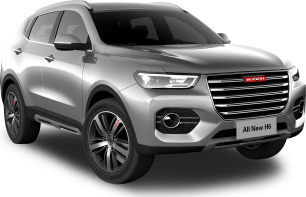Inside is where the Actyon really gets into its groove, as an impressive, thoughtfully engineered family-sized SUV.
Big doors open up nice and wide, revealing a welcoming interior, with a sense of space and airiness, aided by deep windows, large mirrors, a lofty driving position and – in our top-spec K60 test vehicle – the vast glassy sunroof above.
The sporty front seats look and feel fab, fit like a glove and offer plenty of adjustability for a broad range of backs and bottoms alike.
A chunky square-ish steering wheel is good to grip, and, along with the instrumentation’s distinctively angular graphics, gives off lots of BMW vibes.
In fact, it is clear that KGM has been inspired by its latest round of up-spec Kia, Hyundai and even Genesis compatriots when it comes to the Actyon’s fit, finish and presentation. There seems to be no concessions of quality or ambience in order to maintain the Actyon’s keen pricing, and that’s remarkable.
Especially as most things work so well.
Let’s take the 12.3-inch central display. No physical buttons are present, unfortunately, and that’s probably partly due to the modern, clean, horizontal look that today’s designs seem to adopt wholesale.
However, the difference here is that it does not quite suffer the same pitfalls as normal software-based, electronics-heavy set-ups.
Along the left side of the main screen border is a row of permanent fast keys for home, media and climate. Up the top of it is a tab for a temporary menu for fast access to driving modes, stop/start on/off, traction control, camera views, vehicle settings and general settings. While down the right-hand side of the screen border and close to the driver for easy access is a swipe-left tab for a detailed computerised climate-control display. This takes up one-third of screen real estate.
Sounds complicated but it is actually disarmingly intuitive. You're still prodding and swiping screens, and that’s always a potentially-dangerous distraction. But at least nothing is more than a double action away. And almost all functions are also accessible in a dedicated widget home screen. Handy.
Helpfully, KGM also provides a big, physical button on the steering wheel as a ‘favourites’ fast-key to whatever you use most. We set ours for direct drive mode access.
Meanwhile, all of the Actyon’s other main cabin functions, including the climate control, endless storage, twin USB-C ports, varying interior lighting and audio sound of adequate quality, operate without complaint.
Now, while the upper-level materials seem premium, cold and hard lower plastics beg to differ, yet they neither look nor smell cheap, so that’s a win.
But all these favourable first impressions don’t mean there isn’t any room for fixes in this South Korean family truckster.
At the very top of that list should be turfing out the very, very fiddly drive selector. Imitating Volvo’s infinitely more-effective toggle functionality, it needs two, three and even four stabs at selecting Drive or Reverse before engaging. This is a form of torture.
Running close behind is a multimedia system that needs at least 20 seconds to boot up on initial start-up. Not every time, just after a period of inactivity. Painfully slow, it’s also a hazard as the reversing camera won’t operate during this time! Fail.
Other annoyances include the lack of digital radio and wireless Apple CarPlay/Android Auto, meaning you’ll need a cord to access both via your smartphone. And finally, that C-pillar is a massive blind spot.
Meanwhile, out back, all the expected (but not always available in others) amenities are present, like air vents, twin USB-C ports, overhead grab handles, reading lights, coat hooks, a folding armrest with cupholders and an abundance of storage.
But there is also a shocking number of surprise and delight features, including electric front passenger seat adjustment – for slide and recline, adjustable backrest angles, outboard seat heaters, side window blinds, tablet holders incorporated into the back of the front headrests, shallow pockets for smartphone storage set within the larger map pockets, huge door pockets that can hold a 1.5-litre bottle and a back-row speaker-mute function for weary rear-seat travellers needing peace.
When parked, there’s enough space with the backrests dropped for a 180cm person to sleep flat on their back, highlighting the 1440 litres of cargo capacity, or an impressive 668L with all five seats up.
The only note here is that there is no luggage cover to hide valuables (or snooze underneath). Lucky the glass is all heavily tinted. Beneath the floor is a space-saver spare wheel, thankfully.
Overall, then, the Actyon’s cabin is a cavernous, classy and well-equipped affair.






